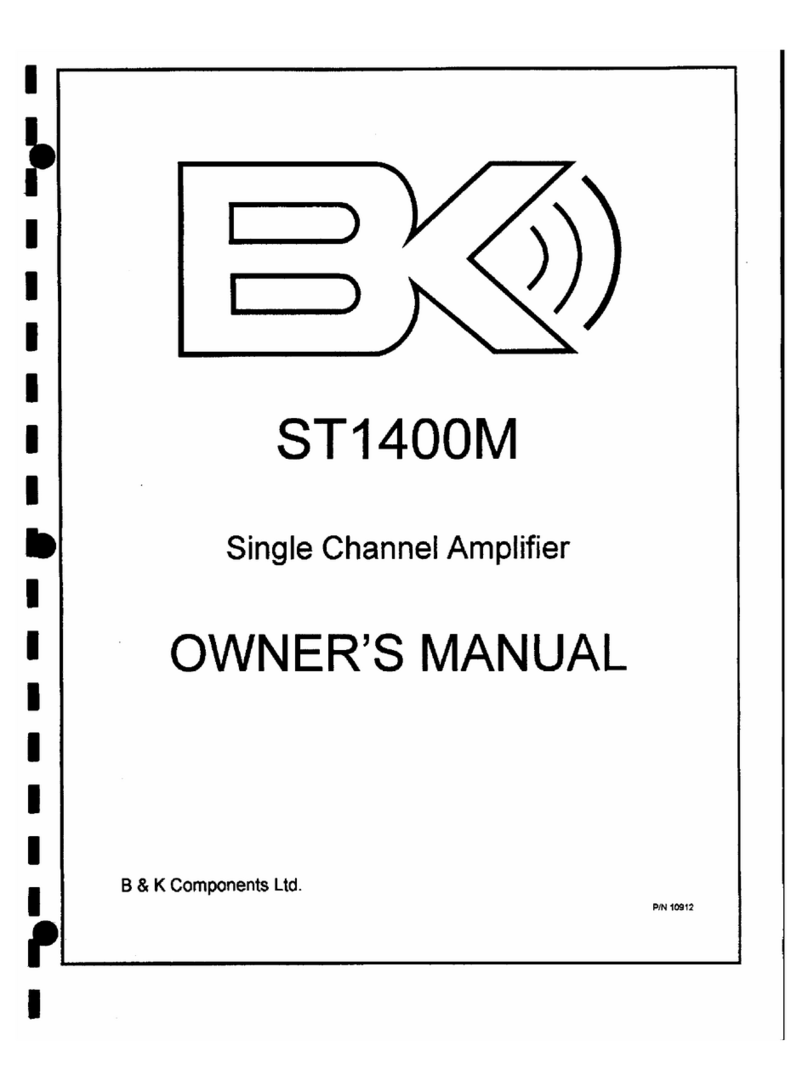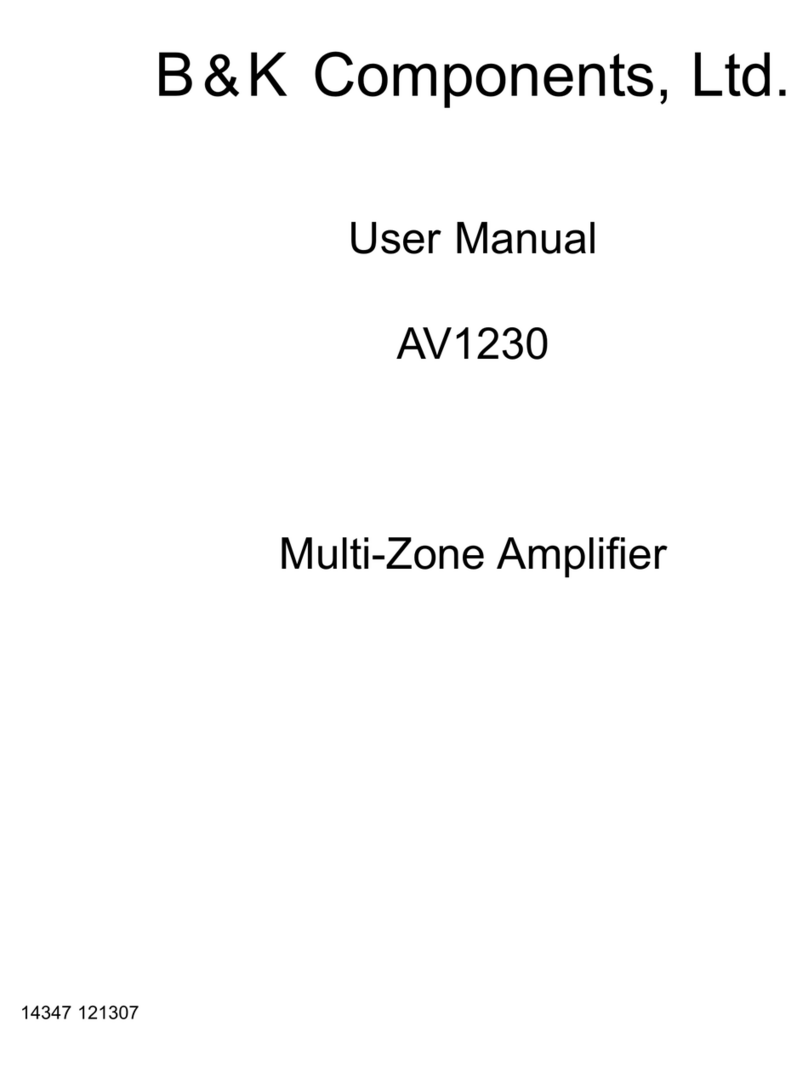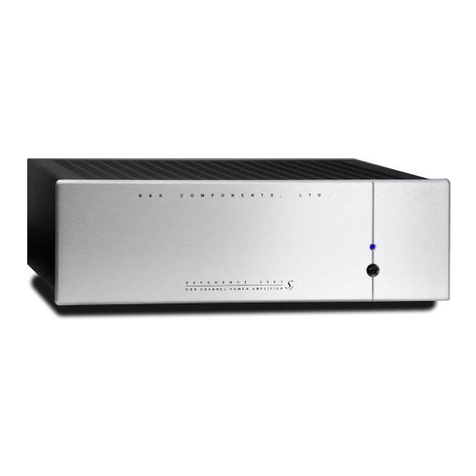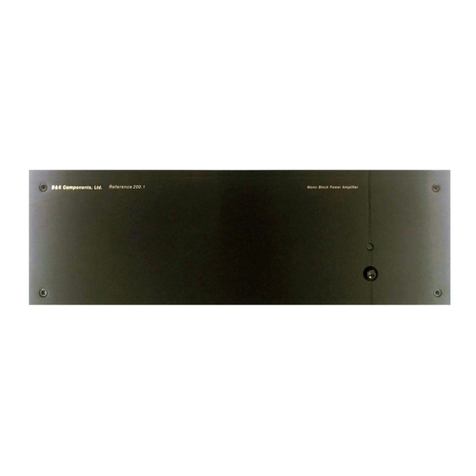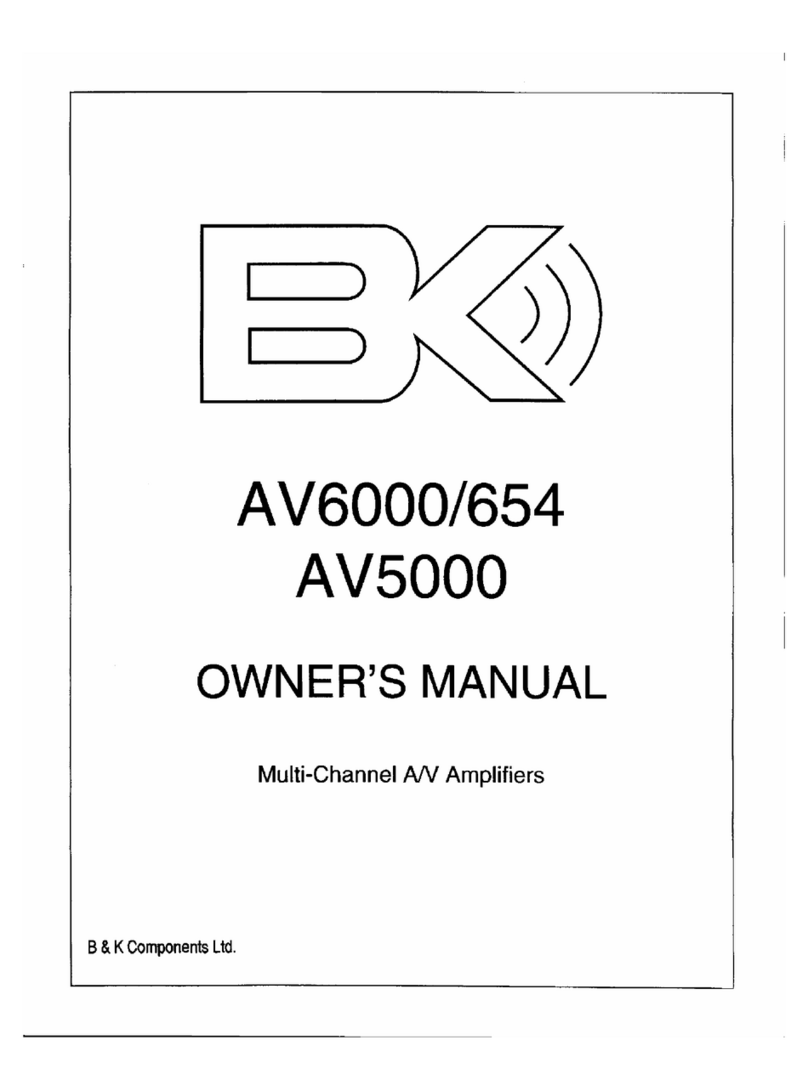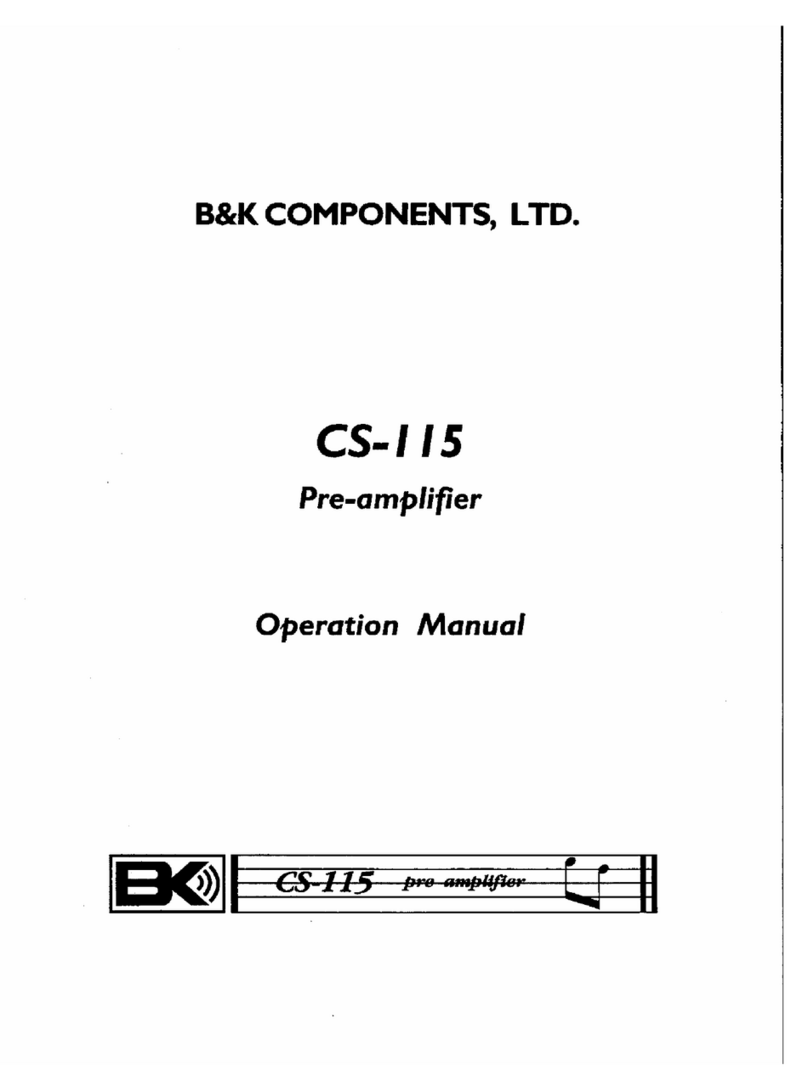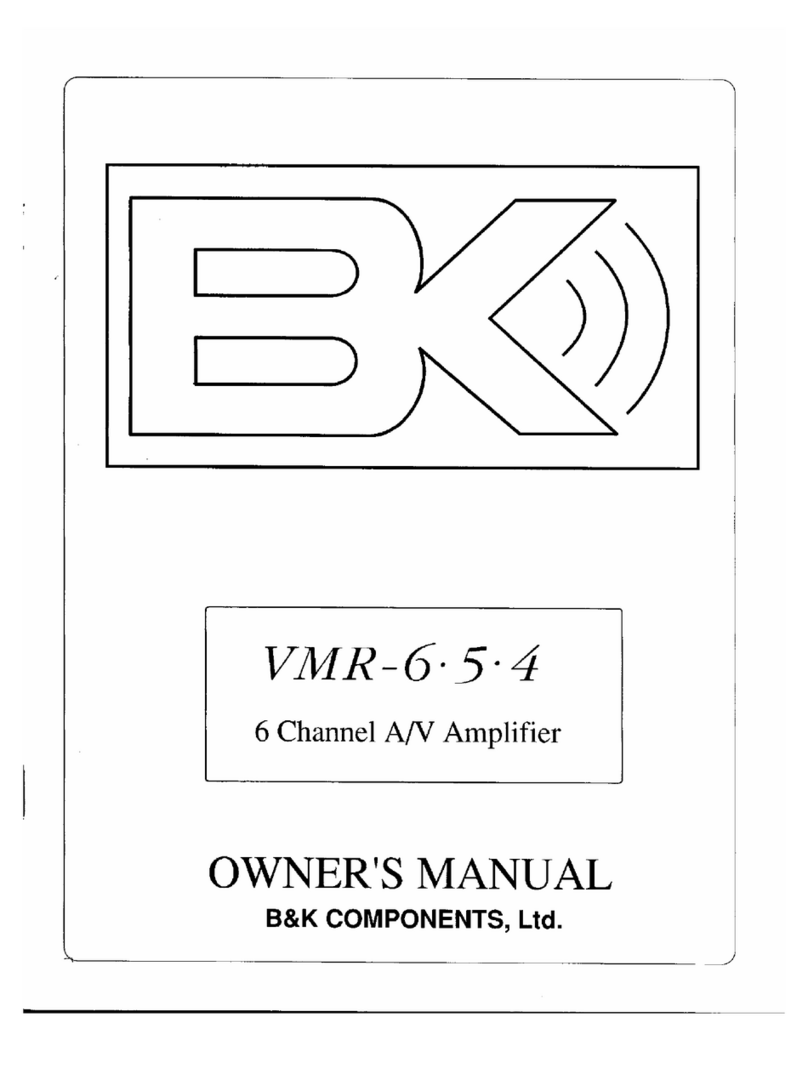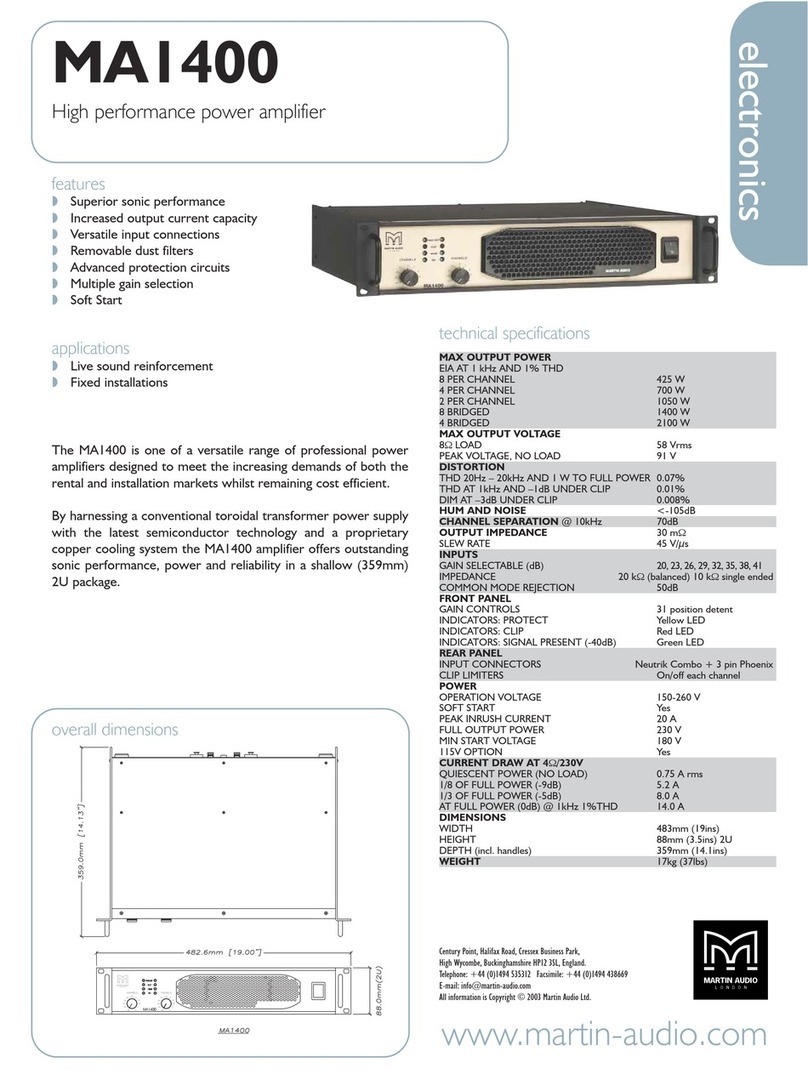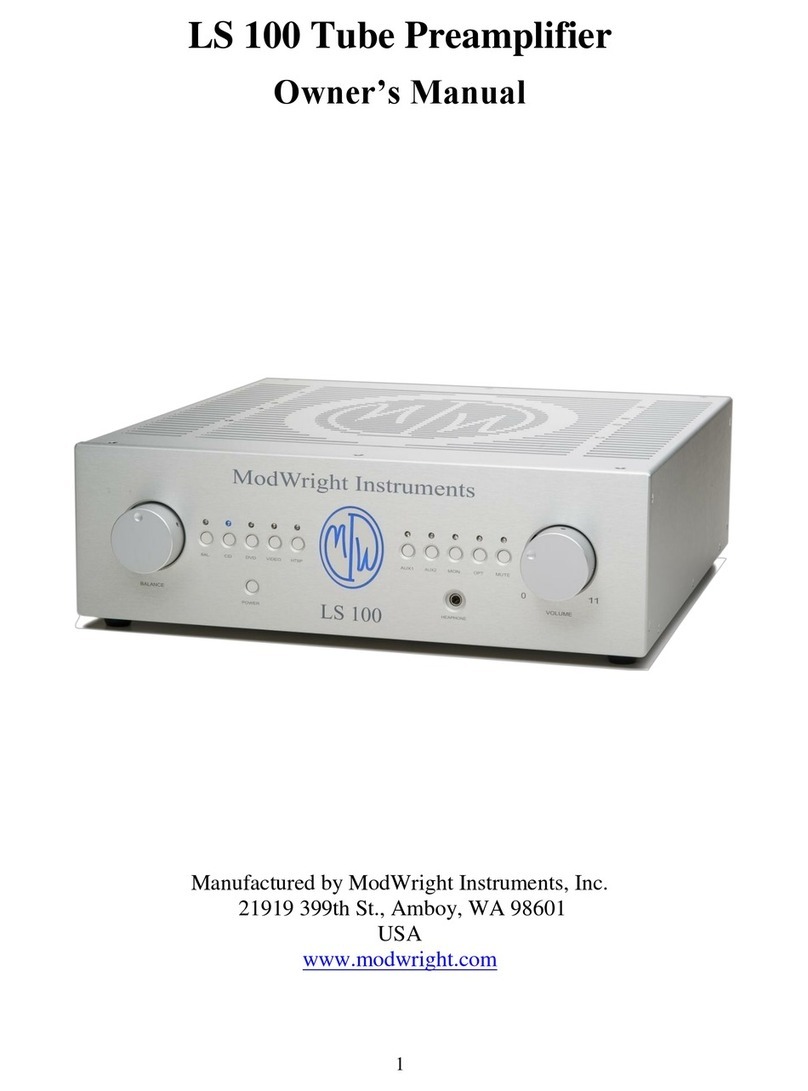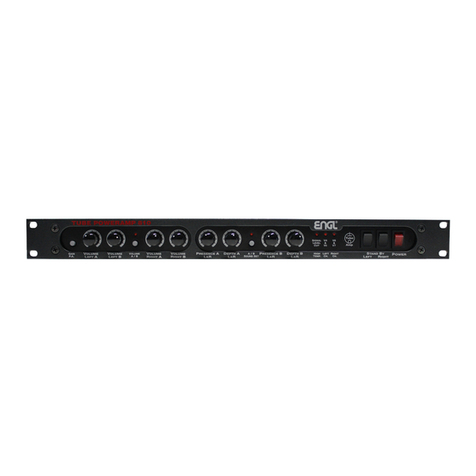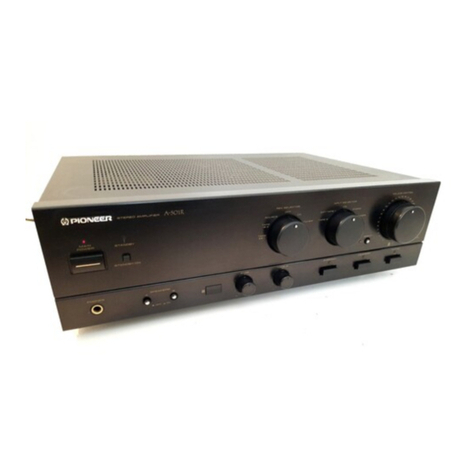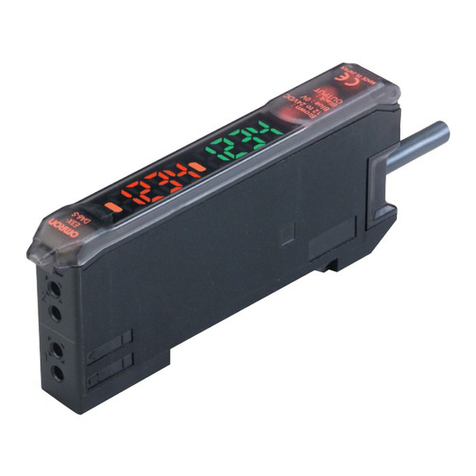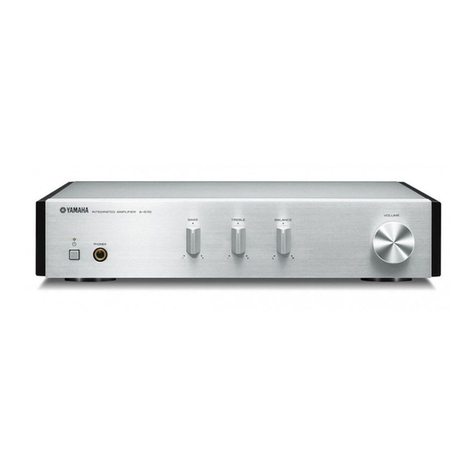B&K PT5 User manual

P/N13447 0103
B&K
SB!IMPLY ETTER
B&K Components, Ltd.
PT5
Owner’s Manual

iii
TABLE OF CONTENTS
Table of Contents ....................................................................................................................................................iii
Safety Precautions .................................................................................................................................................. 1
Features.................................................................................................................................................................... 2
The Basics................................................................................................................................................................ 3
Front Panel ............................................................................................................................................................... 4
Rear Panel ................................................................................................................................................................ 5
Remote Control........................................................................................................................................................ 6
Making the Connection ........................................................................................................................................... 7
Audio Connections ................................................................................................................................................ 8
Using Full Range Speakers................................................................................................................................... 9
Using Small Speakers ......................................................................................................................................... 10
Antenna Connections .......................................................................................................................................... 11
Control I/O ........................................................................................................................................................... 11
Operation................................................................................................................................................................ 12
Power ON/OFF.................................................................................................................................................... 12
Sleep ................................................................................................................................................................... 12
Adjusting Volume ................................................................................................................................................ 12
Choosing a Source.............................................................................................................................................. 13
Headphone Mode................................................................................................................................................ 13
Adjusting Balance................................................................................................................................................ 14
Adjusting Bass..................................................................................................................................................... 14
Adjusting Treble .................................................................................................................................................. 14
Loudness............................................................................................................................................................. 14
Tuner Operation .................................................................................................................................................. 15
Presets ................................................................................................................................................................ 16
Menu ....................................................................................................................................................................... 17
Headphone ON ................................................................................................................................................... 18
Help ..................................................................................................................................................................... 18
Product Info ......................................................................................................................................................... 18
Setup ................................................................................................................................................................... 19
Favorite Preset Setup ....................................................................................................................................... 19
Source Names Setup ........................................................................................................................................ 20
Source Levels Setup ......................................................................................................................................... 20
Preset Operation Setup..................................................................................................................................... 21
Preset Volume................................................................................................................................................... 21
Preset Naming .................................................................................................................................................. 21
Display Setup .................................................................................................................................................... 22
Memory Options................................................................................................................................................ 22
Frequently Asked Questions................................................................................................................................ 23
Advanced Setup Features .................................................................................................................................... 24
Miscellaneous Setup ........................................................................................................................................... 24
Max Level.......................................................................................................................................................... 24
Product ID Code Set and Zone ID .................................................................................................................... 24
Power On Titles................................................................................................................................................... 24
Control Out Setup................................................................................................................................................ 25
Security Options .................................................................................................................................................. 25
Factory Reset ......................................................................................................................................................... 25
Troubleshooting .................................................................................................................................................... 26
Preamplifier Tuner Specifications ....................................................................................................................... 27
Limited Warranty ................................................................................................................................................. 28
Returning Equipment........................................................................................................................................... 28
Menu System.......................................................................................................................................................... 29
Advanced Menu System ....................................................................................................................................... 30
Rear Panel Enlarged View .................................................................................................................................... 31
Notes....................................................................................................................................................................... 32
WWW.BKCOMP.COM ............................................................................................................................................ 33

1
SAFETY PRECAUTIONS
PLEASE READ BEFORE INSTALLING
WARNING: to prevent fire or shock hazard, do not expose this unit to rain or moisture. Care should be
taken to prevent objects or liquid from entering the enclosure. Never handle the power cord with wet
hands.
•The lightning flash with arrowhead, within an equilateral triangle, is intended to alert the user of the
presence of uninsulated “dangerous voltage” within the product’s enclosure that may constitute a risk of
electric shock to you.
•The exclamation point within an equilateral triangle is intended to alert the user of the presence of
important operating and maintenance (servicing) instructions in the literature accompanying the unit.
•Caution: To prevent the risk of electric shock, do not remove cover. No user-serviceable parts inside.
Refer servicing to qualified service personnel.
•Unplug the Preamplifier Tuner from the AC outlet when plugging in or unplugging cables, when left
unused for an extended period of time, when moving, or when you suspect lightning in your area.
•Prevent damage to the power cord. Do not bend, pull, place objects on, alter, etc. Replace the power cord
if it becomes damaged. Always grasp the plug on the power cord when plugging in or unplugging the
Preamplifier Tuner from the AC outlet.
•Your system may produce sound levels capable of causing permanent hearing loss. Do not operate for
extended periods of time at high volume levels.
•Make sure the Preamplifier Tuner is placed on a level surface.
•The Preamplifier Tuner is equipped with raised feet to provide ventilation, reduce acoustic feedback, and
provide protection against scratching the surface the unit is resting on. We advise against removing or
altering feet.
•Do not stack anything on top of the Preamplifier Tuner (processor, source, etc.) Leave a minimum of 2”
clearance from the top of the Preamplifier Tuner to the next shelf (or component) to insure proper
ventilation.
•The Preamplifier Tuner should be located away from other sources that may be sensitive to heat.
•Do not perform any internal modifications to the Preamplifier Tuner.
•Always connect the Preamplifier Tuner’s power cord to an unswitched AC outlet for normal operation.
•If young children are present, adult supervision should be provided until the children are capable of
following all rules for safe operation.
•Do not plug the Preamplifier Tuner’s power cord into an outlet with an unreasonable number of other
devices. Be careful if using extension cords and ensure the total power used by all devices does not
exceed the power rating (watts/amperes) of the extension cord. Excessive loads may cause the insulation
on the cord to heat and possibly melt.
•Mistaking CONTROL OUTPUT or CONTROL INPUT connectors for audio/video inputs or outputs may
damage your Preamplifier or other components.
•Damage may occur to your speakers when the power rating of the driver is exceeded while playing back
music processed by the Preamplifier. Ensure that all the drivers in your system are capable of handling
not only the average power being delivered by the power amplifiers, but also the peak power that is likely
to be generated during strong passages. If you are unsure of your speaker's power rating, contact the
speaker manufacturer or the dealer where you purchased them.
•The Preamplifier Tuner should be serviced by qualified personnel when:
A. The Preamplifier Tuner is not functioning properly.
B. The Preamplifier Tuner was exposed to rain or other type of moisture.
C. The Preamplifier Tuner was dropped, or the chassis is damaged.

2
FEATURES
Your new Preamplifier Tuner is versatile audio control center. The Preamplifier Tuner is designed to sound
sensational and be attractive, easy-to-use addition to your audio system.
Remote Control - Easy control of your B&K Preamplifier Tuner.
Front Panel Operation - Nearly all functions can be controlled directly from the Preamplifier Tuner.
Control Output - One 12 VDC @ 200 mA output for controlling external systems such as a projection screen or
B&K amplifier.
Analog Inputs/Outputs - Six audio inputs and full range, high pass, low pass and mono preamplifier outputs.
Gold Plated Connectors - Better sound with minimum signal loss and degradation.
Presents - 40 present memories allow instant recall of all user settings.
Loudness - May be used to add clarity to the audio signal for low to moderate listening levels.
Bass - May be used to adjust room equalization.
Treble - May be used to adjust room equalization.
Customized Input and Present Names - Assign names to presents, inputs, or the turn on message.
Internally Digitally Synthesized AM/FM Stereo Tuner - Stores up to 40 AM or FM presets.
IR Output - One IR output allows integrating the Preamplifier Tuner with an infrared repeater control system.
Control I/O - A single 5 pin plug-in Phoenix connector allows easy system interface to the preamplifiers 12VDC
power source, one Infrared Data/Signal, one RS232 transmitter and a 12 VDC programmable trigger.
RS232 - RS232 Two Way communication allows for enhanced system control and interface.

3
THE BASICS
The following is intended to familiarize users with common terms and applications of home audio equipment.
Amplifier - An amplifier takes the output of a preamplifier and increases its level to that necessary to drive a
speaker. Your preamplifier Tuner includes full-range, high-pass, low-pass and mono preamplifier outputs for
connecting to external amplifiers and/or powered speakers.
Preamplifier - A preamplifier typically includes the capability to select from a number of sources, adjust volume
levels and route the signal to an amplifier. Optionally the preamplifier may include the capability to process the
audio signal to adjust for room and listening taste preferences. Your Preamplifier Tuner is capable of adding or
subtracting bass and treble to correct for any needed room equalization. A loudness circuit may be used to further
shape the audio signal for increased clarity and intelligibility at low levels.
Sources - Your Preamplifier Tuner can directly provide audio from its built-in AM/FM tuner. Typically you will want
to connect a number of additional sources (CD, DVD player, etc.) to your Preamplifier Tuner. Your Preamplifier
Tuner is designed to accommodate a wide range of audio sources.
Speakers and Bass Management - An audio system typically uses 2 speakers located front left and right.
Additionally, a sub woofer may be used with good results anywhere in the room. Small speakers usually require a
crossover to remove low frequency (bass) audio and pass this on to a sub woofer. You Preamplifier Tuner
includes an electronic crossover that adds the capability to work with large speakers (full range), or small
speakers (high-pass) and a sub woofer (low-pass). Excellent results can also be achieved using large speakers
and a sub woofer.
Zone - A zone is usually a room with speakers installed in it. Using Code Sets, your Preamplifier Tuner may be
configured for use in systems of up to 16 zones.

4
FRONT PANEL
SLEEPHEADPHONE PRESET ENTER SAVE TUNE - TUNE + SOURCE LOUDNESS
POWER
ON/OFF
PT 5 TUNER PREAMP
Components,
&KB Ltd.
PT 5 PREAMP
LEVEL
1 2 3 54
1. Headphone Jack - Stereo headphones having a standard ¼ inch binaural plug can be connected to the
headphone output. The Preamplifier Tuner must be on and in HEADPHONE Mode for proper headphone
operation.
2. Front panel buttons
SLEEP
PRESET
ENTER
SAVE
DOWN UP
SOURCE
LOUDNESS
LEVEL
Puts the Preamplifier Tuner in and out of standby mode.
Steps through audio presets for instant recall of setups.
Pressing ENTER recalls the preset.
Confirm selection
Pressing PRESET and ENTER simultaneously will enter the MENU state.
Save a preset.
Press ENTER to accept.
Allows tuning - (down), or tuning + (up) of the AM / FM tuner.
While in MENU steps through menus, sources, or characters.
Steps through the audio sources.
Engages an audio intelligibility circuit for low level listening.
Selects VOLUME, BALANCE, BASS, or TREBLE level to be adjusted via
the rotational encoder.
3. Display - The Preamplifier Tuner display is a 16 character alphanumeric fluorescent display. Displays current
status of the Preamplifier Tuner and any changes being performed.
4. Volume control - For controlling system volume. Turning the rotational encoder control clockwise increases
the volume level, counterclockwise decreases the volume level. The volume knob is also used to change other
Tuner and preamplifier settings. See OPERATION and MENU SYSTEM sections in this manual.
5. Main power switch - Removes all power to the Preamplifier Tuner. Normal operation of the Preamplifier Tuner
requires the power switch to remain on. Use the Sleep button for daily on and off of the Preamplifier Tuner. It
places the unit in standby mode that allows turning back on with the remote control. Turn the Preamplifier Tuner
off with the main power switch when not using it for an extended period of time.

5
REAR PANEL
V1V2TV
SOURCE INPUTS
DVD
CD
INPUT
OUTPUT
TAPE
PREAMP OUTPUTS
FULL
RANGE
HIGH
PASS
SUB
MONO
L+R
GROUND
RS232 TRANSMIT
DATA IN
Audio/Video Systems - Made in the U.S.A.
BK&
SBIMPLY ETTER!
RISK OF ELECTRIC SHOCK
DO NOT OPEN
CAUTION
ANTENNA
AM
FM
VOLTAGE
~
AC LINE
RS-232 IR
OUTPUT
BALANCED OUTPUT
FULL RANGE
LEFT RIGHT
SERIAL #
CTRL OUT
+12V
200 mA Total
Max Current
8
932647
510 111
The Preamplifier Tuner’s back panel is organized into groups of inputs and outputs as shown below. See back of
this manual for an enlarged view.
1. AC input receptacle - For attaching the supplied AC power cord to the Preamplifier Tuner.
The serial number of your unit is located above the AC input receptacle
2. RS232 - RS232 Two Way communication allows for enhanced system control and interface.
3. IR output - IR remote signals detected by your Preamplifier’s front panel or the Control Out Infrared
Data/Signal input pin are repeated on this IR output connector
4. Control I/O - The PT5 allows connections to zone keypad/sensors via a 5 pin plug-in Phoenix connector.
+12V - +12V Power to Keypad or IR Sensor
Ground - Common Ground
RS232 Xmit - RS232 One Way Transmit
Data In - Infrared Data/Signal
CTRL Out - 12V Programmable Control Out
5. FULL RANGE XLR Balanced outputs - Variable preamp outputs for driving external power amplifiers.
Pin 1 - ground
Pin 2 - input +
Pin 3 - input –
6. MONO L+R and SUB PREAMP outputs - Variable level outputs for driving external power amplifiers or
powered speakers. Mono is the summation of the L+R full range audio signals that is then processed by a low-
pass filter to reduce audio above 80 Hz to source the SUB output.
7. HIGH PASS RCA outputs - Variable preamp outputs for driving external power amplifiers or powered
speakers. These outputs have been processed through a high pass filter to reduce audio below 80 Hz. Use these
outputs for small speakers or in a sub woofer / satellite system. Note: these outputs are identical to the full range
outputs with the addition of an 80 Hz 12 dB / Octave high-pass filter.
8. FULL RANGE RCA outputs - Variable preamp outputs for driving external power amplifiers.
9. TAPE inputs and outputs - Fixed level output for use with an audio recorder and a return for a tape monitor.
10. Line inputs - Connections from your audio sources.
Red RCA jacks - right analog audio
White RCA jacks - left analog audio
11. Antenna inputs - Connections for the AM and FM antennas.

6
REMOTE CONTROL
Your Preamplifier Tuner includes an IR remote control.
SEL
2 3
5 6
8
0
9
E
1BAND
ST/M
4
7
+10
MENU
MODE
A
TVDVD SAT V2
MUTE
ON
VOL
CD
V1
TAPE
TUNER
BAL L BAL R
TUNE
BASS TREBLE
B&K REMOTE CONTROLLER
POWEROFF
LOUDNESS SAVE
FM
AM
PRE

7
MAKING THE CONNECTION
It’s tempting to just plug in your new Preamplifier Tuner and have great sound pour out. Before you do that, take a
few minutes to plan out how you want the Preamplifier Tuner to fit into your audio system. Ask yourself the
following questions:
yWhat source components do I want to connect to my Preamplifier Tuner? (CD, DVD, etc.)
yWhat equipment will be receiving the audio? (Amplifier, Powered Speakers, etc.)
The answers to your questions determine how many cables you need to connect to the back of the Preamplifier
Tuner. Good preplanning equals great sound. Keep these recommendations in mind:
yList all components in your system and indicate which jacks of the Preamplifier Tuner each component will be
connected to. Your Preamplifier Tuner has six sets of inputs. It is convenient to connect a DVD player to the
input labeled DVD or a VCR to the input labeled V1 or TAPE, etc. However, your equipment may differ from
the labeling on the back of your Preamplifier Tuner. In most cases you can connect any type of source to any
input (see FREQUENTLY ASKED QUESTIONS). For example, if you have a satellite receiver you can
connect it to V2. You can also reprogram the source name that will appear on your Preamplifier Tuner’s front
panel. (See SETUP - SOURCE NAMES)
yAlso note the length of the cable for each component’s connection and describe how it should be routed or
draw your routing scheme below your list. You may want to label each cable with a name or number at both
ends. Use high quality connections to maintain high quality audio.
yThink about the type and length of cable you need and obstacles in the cable’s path (doorways, furniture,
walkways, etc.). To decide which ones are right for you talk to your dealer about the various cable products
that are available.
yFor safety, keep all cables out of high traffic areas (hallways or doorways) and away from equipment that
radiates power, including amplifiers, power cords, heaters, etc.
yIf you might expand your audio system later, keep these ideas in mind as you plan current cable runs.
yTo provide the best tuner reception, make sure the antenna is at least several feet away from the Preamplifier
Tuner and any other equipment that may produce high frequency interference such as Personal computers,
CD players, halogen lamps, etc.
Take a look at the back panel of the Preamplifier Tuner. You will notice that the RCA-type audio input and output
connectors are identified by colors, red for right channel and white for the left channel audio.

8
AUDIO CONNECTIONS
Connecting your analog sources to your Preamplifier Tuner
Audio source - connecting a CD player to the Preamplifier Tuner’s analog inputs. Use the same instructions for
connecting to other audio sources such as a DVD, television, satellite receiver, cable box, etc. Attach one end of
the audio interconnect cable to the left audio output on the CD player, then attach the other end to the left (white)
CD audio input on the Preamplifier Tuner. Repeat for the right (red) audio connection.
SOURCE INPUTS
CD
R
L
Right Audio Input
From CD Player
Left Audio Input
From CD Player
TAPE or audio recorder - connect a cassette deck or other recorder to TAPE.
Attach one end of the audio interconnect cable to the left audio output on the TAPE recorder, then attach the
other end to the left (white) TAPE audio input on the Preamplifier Tuner. Repeat for the right (red) audio
connection.
INPUT
OUTPUT
TAPE
R
L
Right Audio Input
From TAPE Output
Left Audio Input
From TAPE Output
R
L
Right Audio Output
To TAPE Input
Left Audio
TAPE Input
Output
To
Attach one end of the audio interconnect cable to the left audio input on the TAPE recorder, then attach the other
end to the left (white) TAPE audio output on the Preamplifier Tuner. Repeat for the right (red) audio connection.

9
USING FULL RANGE SPEAKERS
Connect the Preamplifier outputs to your external amplifier(s) or powered speakers.
Shown below is a typical Preamplifier output setup for use with large speakers:
Note: the use of a sub woofer is optional.
Left Speaker
(Large)
Right Speaker
(Large)
(-) (+)
CHANNEL 1 OUTPUT CHANNEL 2 OUTPUT
F
U
S
E
F
U
S
E
F
U
S
E
F
U
S
E
F
U
S
E
F
U
S
E
(-) (+)
PREAMP OUTPUTS
FULL
RANGE
HIGH
PASS
SUB
MONO
L+R
BALANCED OUTPUT
FULL RANGE
LEFT RIGHT
OR
Left Speaker
(Large)
Right Speaker
(Large)
(-) (+)
CHANNEL 1 OUTPUT CHANNEL 2 OUTPUT
F
U
S
E
F
U
S
E
F
U
S
E
F
U
S
E
F
U
S
E
F
U
S
E
(-) (+)
PREAMP OUTPUTS
FULL
RANGE
HIGH
PASS
SUB
MONO
L+R
BALANCED OUTPUT
FULL RANGE
LEFT RIGHT
L
L
R
R
L
R
L
R
Button Pushed In
Button Out
SUB output - Connect an RCA cable from the Preamplifier Tuner’s SUB output. If your subwoofer does not
contain its own amplifier you will need to purchase an external B&K or other power amplifier. Connect the
Preamplifier Tuner’s SUB output to the audio input of the external amplifier. Connect the external amplifier’s
speaker output to your subwoofer. If you prefer to use your subwoofer’s internal crossover, connect to the
Preamplifier Tuner’s Mono output.

10
USING SMALL SPEAKERS
Connect the Preamplifier outputs to your external amplifier(s) or powered speakers.
Shown below is a typical Preamplifier output setup for use with small speakers:
Note: the use of a subwoofer is not optional and is needed to reproduce low frequency audio material.
Left Speaker
(Small)
Right Speaker
(Small)
CHANNEL 1 OUTPUT CHANNEL 2 OUTPUT
F
U
S
E
F
U
S
E
F
U
S
E
F
U
S
E
F
U
S
E
F
U
S
E
(-) (+)
PREAMP OUTPUTS
FULL
RANGE
HIGH
PASS
SUB
MONO
L+R
BALANCED OUTPUT
FULL RANGE
LEFT RIGHT
L
L
R
R
Button Out
(-) (+)
SUB output - Connect an RCA cable from the Preamplifier Tuner’s SUB output. If your subwoofer does not
contain its own amplifier you will need to purchase an external B&K or other power amplifier. Connect the
Preamplifier Tuner’s SUB output to the audio input of the external amplifier. Connect the external amplifier’s
speaker output to your subwoofer. If you prefer to use your subwoofer’s internal crossover then connect the
Preamplifier Tuner’s full range outputs to the sub’s input and connect your power amplifier or powered speaker’s
to the sub’s high-pass output.

11
ANTENNA CONNECTIONS
The FM jack is a standard screw on F-type connector.
The AM is a push type. Strip ¼ inch of insulation off your
AM antenna wires and insert one wire end into each
hole while holding the tabs down. Release the tabs to
lock in the AM antenna wires.
IR Output - The Preamplifier has the capability to be controlled by an Infrared Data/Signal (see below). IR Data
detected from the Preamplifiers front panel, or the rear panel Data/Signal, are electrically ORed together and sent
out this IR Output mini-jack. The plug must be wired as tip (+) and the long barrel section (-). This connector may
be used as an IR blaster for further system control and interface applications.
CONTROL I/O
Control I/O - These connections are for use when interfacing other equipment such as Keypads, an external
amplifier, projection screen, etc. The PT5 allows connections to zone keypad/sensors via a 5 pin plug-in Phoenix
connector.
+12V - +12V Power to Keypad or IR Sensor
Ground - Common Ground
RS232 Xmit - RS232 One Way Transmit
Data In - Infrared Data/Signal
CTRL Out - 12V Programmable Control Out
Note - The control output is capable of sourcing a maximum of 12VDC @200 mA. Check to see that the source
you are connecting to the control out requires 200 mA or less current.
Control Out (CTRL Out) - The factory default CTRL Out settings is HEADPHONE - On (+12 VDC) when the unit
is on and not in Headphone mode, Off when the unit is off or in Headphone Mode. This mode may be used for
controlling external amplifiers or powered sub woofers in an audio zone. The other Control Out (CTRL Out) option
settings are OFF, POWER and RS232.
The Control I/O CTRL Out pin is programmable for each source in your system (see “Advanced Setup”).
However, the Preamplifier Tuner provides the following factory preprogrammed setup that should serve for most
standard system applications. Connect your control cable to the Preamplifier using a mono 3.5 mm mini-jack
shown at left. The plug must be wired as tip (+) and the long barrel section (-).
WARNING - Not all manufacturers adhere to
the +12 VDC control specification. Check to
see if your sources control inputs are +12 VDC
compatible. Do not connect your Preamplifier
control outputs to a device with control inputs
rated less than 12 VDC before checking
compatibility with the manufacturer as damage
to your source may result.
FM antenna
TUNER
AM antenna
FM Antenna Input
from Indoor/Outdoor Antenna,
Cable Box, etc.
AM Antenna Input
from Loop Antenna
GROUND
RS232 TRANSMIT
DATA IN
RISK OF ELECTRIC SHOCK
DO NOT OPEN
CAUTION
VOLTAGE
~
AC LINE
RS-232 IR
OUTPUT
SERIAL #
CTRL OUT
+12V
200 mA Total
Max Current
12 V Control Out
To Control In
on B&K Amplifier
To B&K
In-Wall
Keypad
To IR
Repeater
OR

12
BK
B & K COMPONENTS
MADE IN THE USA PT 5 PREAMP VERSION 1.01
OFF PLEASE WAIT
OPERATION
The following outlines the normal day-to-day operation of your Preamplifier Tuner from the supplied IR remote
controller or directly from your Preamplifier Tuner’s front panel.
POWER ON/OFF
The main power switch on the front panel of your Preamplifier Tuner must be on for the Preamplifier Tuner to
operate. When this switch is off all power is removed from your Preamplifier Tuner. This prevents turning it back
on with the remote control. You can use the main power switch for normal day to day operation but we suggest
you use the sleep function instead so that the Preamplifier Tuner can be turned on and off from the remote. After
turning on the main power you must wait approximately 10 seconds while your Preamplifier Tuner restores its
internal memory and initializes various parameters. You may want to turn off the main power switch when your
Preamplifier Tuner will be idle for extended periods of time or during periods of power line fluctuations. Your
Preamplifier Tuner will not lose its memory while the main power switch is off.
PLEASE WAIT
From Remote From Front Panel Action
Can’t turn off main power from remote POWER ON/OFF main power on/off
SLEEP
Normally you will simply put your Preamplifier Tuner to sleep (standby) when not in use. Sleep mode keeps a
bare minimum of functions running in order to allow remote control operation and fast start up. Note that the front
panel SLEEP button is lit while your Preamplifier Tuner is asleep and is off when your Preamplifier Tuner is
operating. The front panel alphanumeric display is off during sleep. Also note that the supplied IR remote’s
POWER button is a toggle to put your Preamplifier Tuner in and out of sleep. The remote control also has
separate OFF and ON buttons.
From Remote From Front Panel Action
1 ON or POWER eSLEEP bring Preamplifier Tuner out of standby
2 OFF or POWER eSLEEP put Preamplifier Tuner to sleep (standby)
ADJUSTING VOLUME
From Remote From Front Panel Action
VOL - or VOL + VOLUME KNOB adjust volume
MUTE Can’t do from front panel instant volume all the way down press MUTE again to restore
Note: The front panel VOLUME control is also used to control multiple functions and, therefore, cannot always
control the LEVEL. The front panel display will indicate which LEVEL is currently being modified (VOLUME,
BALANCE, BASS, or TREBLE). The VOLUME KNOB never controls volume in the menu system. During normal
operation the VOLUME KNOB may switch to controlling other functions but will return to MASTER LEVEL after a
few seconds. The remote’s VOL −or VOL + will always change master volume level except in the SOURCE
LEVEL menus.
CD VOLUME -20

13
CHOOSING A SOURCE
In general, the selected source will appear at the PREAMP outputs and the TAPE output.
From Remote From Front Panel Action
Desired source (SOURCE) step to source select desired source
TAPE MONITOR - If you have an analog three-head cassette or reel-to-reel analog tape recorder you may wish
to use TAPE MONITOR, which allows you to hear exactly what is on the tape as you are recording
From Remote From Front Panel Action
Desired source (SOURCE) step to source select desired source or TUNER
source will appear on TAPE output
wait a few seconds while Preamplifier
Tuner analyzes selected source
TAPE (SOURCE) step quickly to
TAPE
select TAPE monitor
TAPE will appear at the preamp’s output
HEADPHONE MODE
Headphone Mode allows you to operate your Preamplifier Tuner with the CONTROL OUT set to off. This feature
allows your Preamplifier Tuner to turn off external amplifiers or powered sub woofers with compatible CONTROL
inputs. Your Preamplifier Tuner has the capability to be set up to allow for other control out functions (see
ADVANCED FEATURES).
From Remote From Front Panel Action
1 MODE Can’t do directly from front panel refer to MENU operation toggle headphone on/off
CD -20 DB
TAPE -20 DB
HEADPHONE OFF HEADPHONE ON

14
ADJUSTING BALANCE
BAL (L) positions the source left by decreasing the right channel level. BAL (R) positions the source right by
decreasing the left channel level.
From Remote From Front Panel Action
¶(BAL L) or •(BAL R) ∠(LEVEL) step to BALANCE then use VOLUME KNOB adjust balance left or right
ADJUSTING BASS
BASS +/- increase or decrease the low frequency content in 2 dB increments with a range of +/- 12 dB.
From Remote From Front Panel Action
BASS – or BASS + ∠(LEVEL) step to BASS then use VOLUME KNOB adjust bass up or down
ADJUSTING TREBLE
Treble +/- increase or decrease the high frequency content in 2 dB increments with a range of +/- 12 dB.
From Remote From Front Panel Action
TREBLE - or TREBLE + ∠(LEVEL) step to TREBLE then use VOLUME KNOB adjust treble up or down
LOUDNESS
Loudness may be used to further shape the audio signal for increased clarity and intelligibility at low listening
levels.
From Remote From Front Panel Action
LOUDNESS (LOUDNESS) toggle on or off
CD CENTERED CD RIGHT - 2
to
CD BASS + 2
CD TREBLE - 2
CD LOUD ON CD LOUD OFF
or

15
TUNER OPERATION
All TUNER operations require the Preamplifier Tuner’s source be set to TUNER.
Manual Tuning - press TUNE + or TUNE - to tune the frequency UP or DOWN in single 10 kHz steps for AM or
200 kHz steps for FM. (9 kHz and 100 kHz steps for European version.)
Direct Frequency Entry Tuning - for a few seconds after performing any tuner operation (TUNER, BAND, AM,
FM or TUNE+/-) you may directly enter a frequency from the remote control’s numeric keypad.
Seek Tuning - Holding the remote TUNE +/- button will cause the tuner to SEEK (tune up or down automatically
stopping on strong stations). Once the tuner has started seeking you can let go of the button. Once a station is
found you must let go of the button before you can change frequencies again. In strong signal areas the tuner
may stop one step above or below the true frequency. Unless you are sure of the station’s frequency, check to
see that the signal might be better one step above or below the frequency that SEEK has found. In weak signal
areas the tuner may continue to seek all the way to the end of the band. To stop this simply press the opposite
TUNE +/- button.
BAND - toggles between the AM and FM frequency bands.
AM - selects and allows tuning of the AM frequency band.
FM - selects and allows tuning of the FM frequency band.
ST/M - allows selecting of Stereo and Mono in the FM frequency band. Setting/Programming a channel to Stereo
will play the channel in stereo if it is broadcast in stereo or in mono otherwise. Setting/Programming a channel to
Mono will force the channel to mono regardless of the broadcast. Use mono to reduce background noise on weak
channels.
From Remote From Front Panel Action
1 TUNER (SOURCE) step to source select TUNER
2 BAND or AM or FM (SOURCE) step to source select AM or FM
3 TUNE+ or TUNE- .(UP) or -(DOWN) and then manually tune up or down to desired frequency
see TUNER OPERATION for DIRECT/SEEK/
TUNE
4 ST/M Can’t do directly from front panel
refer to MENU operation
set FM stereo/mono
FM 102.5 SEEK FM ST 104.1 FOUND
to
FM STEREO FM MONO
to
FM 104.1 -16

16
PRESETS
Presets allow you to save your favorite settings and recall them instantly. Your Preamplifier Tuner can store forty
presets (0.39). Most Preamplifier Tuner’s only allow saving of tuner stations. With the presets you save not only
the tuner station but also the volume, bass, treble, balance, loudness, and headphone mode. This allows you, for
example, to save a music station with enhanced bass and a talk station with enhanced treble. You are not limited
to 20 AM stations and 20 FM stations. You can save 1 AM station and 39 FM stations, 1 FM and 39 AM or
anything in between. Also, presets are not limited to Tuner stations. You can save custom settings for any source.
A convenient set of 10 presets come preprogrammed with your Preamplifier Tuner.
Recalling a Preset
From Remote From Front Panel Action
1 Number or +10 + number ◊(PRESET) step to desired preset review settings for recall
2 SEL or ENTER ↵(ENTER) recall preset
Saving a Preset
From Remote From Front Panel Action
1 Make all settings you wish to save make all settings you wish to save prepare for saving preset
2 SAVE (SAVE) activate preset save
3 number or +10 + number ◊(PRESET) step to desired preset Select preset number you wish
to replace
4 Àor §
¶(BAL L) or •(BAL R)
.(TUNE +) or -(TUNE -)
VOLUME KNOB
rename preset if desired
5 SEL or ENTER ↵(ENTER) save preset
1 cd -20 db RECALLING PRESET
11 cd -15 db SAVING SETTINGS

17
MENU
For best results, perform the following set up procedure when you initially install your Preamplifier Tuner and
anytime you change or add sources, speakers, etc. or when you rearrange your listening area
THE MENU SYSTEM
Setup of your Preamplifier Tuner will require you to navigate through the menu system via the front panel or
remote. A complete guide to the menu system is included at the back of this manual. We recommend that you
become familiar with your Preamplifier Tuner’s menu guide. The following are general instructions for using the
menu system.
MENU - If you are not already in the menu system, the MENU button on the remote controller will activate the
menu system (or, simultaneously pressing PRESET and ENTER from the front panel). Once you are in the menu
system, the MENU button will return you to the next higher-level menu or, if you are already at the highest level, it
will exit from the menu system.
UP/DOWN ARROWS - Once you are in the menu system, use the TUNE+ / TUNE- ARROWS to move to the
desired menu selection.
SELECT (remote) or ENTER (remote or front panel) - Some menu selections cause another menu to be
activated. Use the TUNE+ / TUNE- ARROWS to move to the desired menu line. Pressing SELECT or ENTER will
activate the next menu.
LEFT/RIGHT ARROWS (remote) or VOLUME KNOB (front panel) - Some menu selections allow you to change
one of the Preamplifier Tuner settings. Use the TUNE+ / TUNE- ARROWS to move to the desired menu line.
Pressing the LEFT/RIGHT ARROWS will change the setting. There are no LEFT/RIGHT ARROWS on the front
panel. While in the menu system, the VOLUME KNOB acts as the LEFT/RIGHT ARROWS. This means that you
will not be able to adjust the volume from the front panel while in the menu system. The remote control volume
will work in most menus.
TEXT EDITING - Some menu selections will require you to edit text. Use the TUNE+ / TUNE- ARROWS to
change the current (blinking) character. Use the LEFT/RIGHT ARROWS (or VOLUME KNOB) to move to another
character position.
Table of contents
Other B&K Amplifier manuals
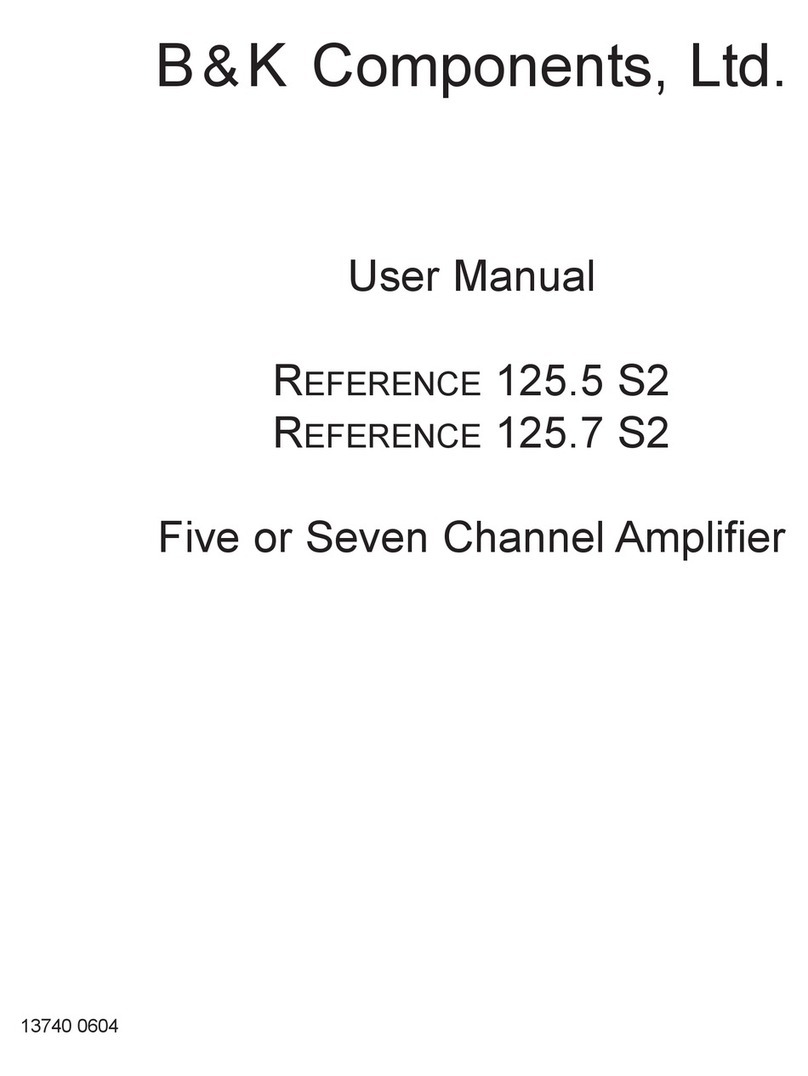
B&K
B&K FIVE OR SEVEN CHANNEL 125.5 S2 User manual

B&K
B&K ST1430 Series II User manual
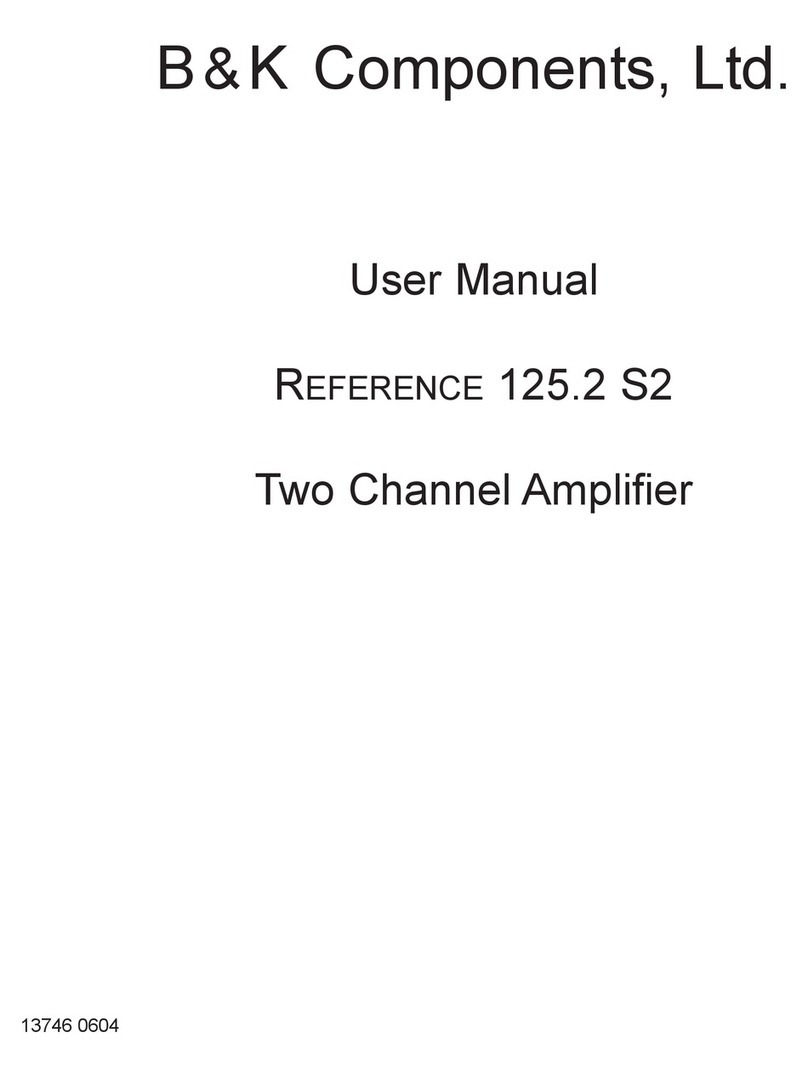
B&K
B&K Reference 125.2 Series II User manual

B&K
B&K Reference 3220 User manual
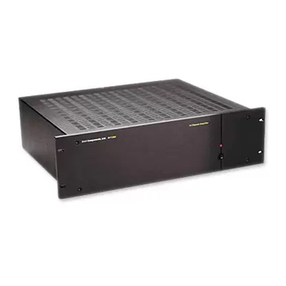
B&K
B&K AV5125 User manual
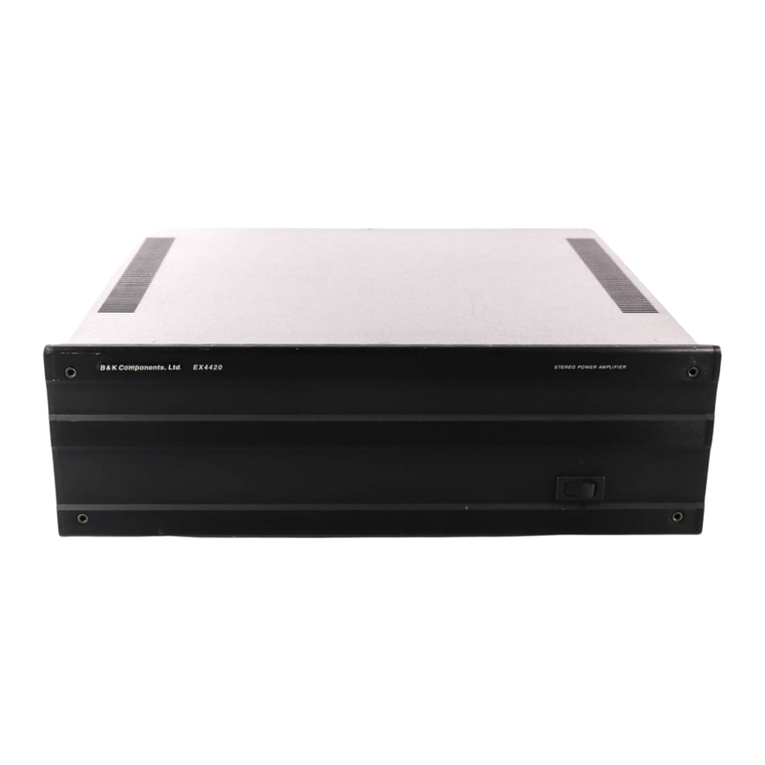
B&K
B&K EX4420 User manual

B&K
B&K Reference 220M User manual
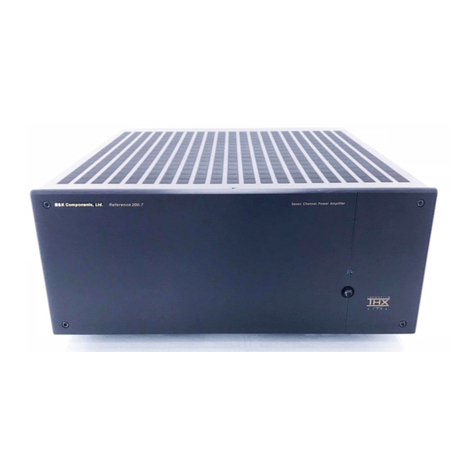
B&K
B&K P/N13445 User manual
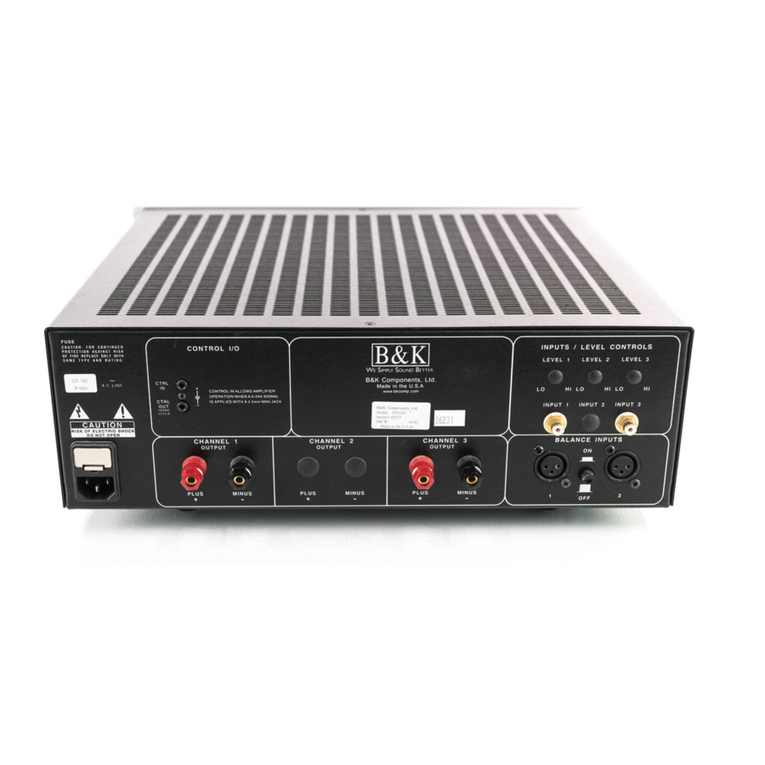
B&K
B&K ST2140 User manual

B&K
B&K Reference 70 HT 70 User manual
Popular Amplifier manuals by other brands

RedPlate
RedPlate BlackVerbDue Operation manual
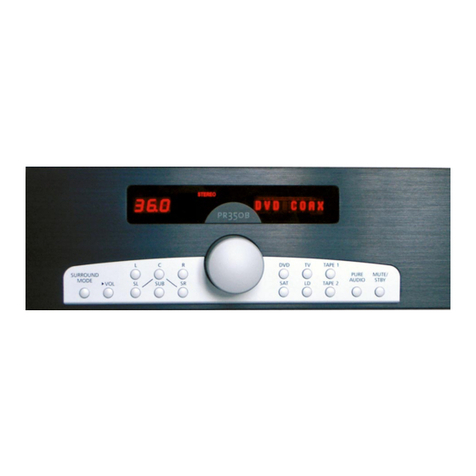
Thule Audio
Thule Audio SPACE PR350 B V350 owner's manual
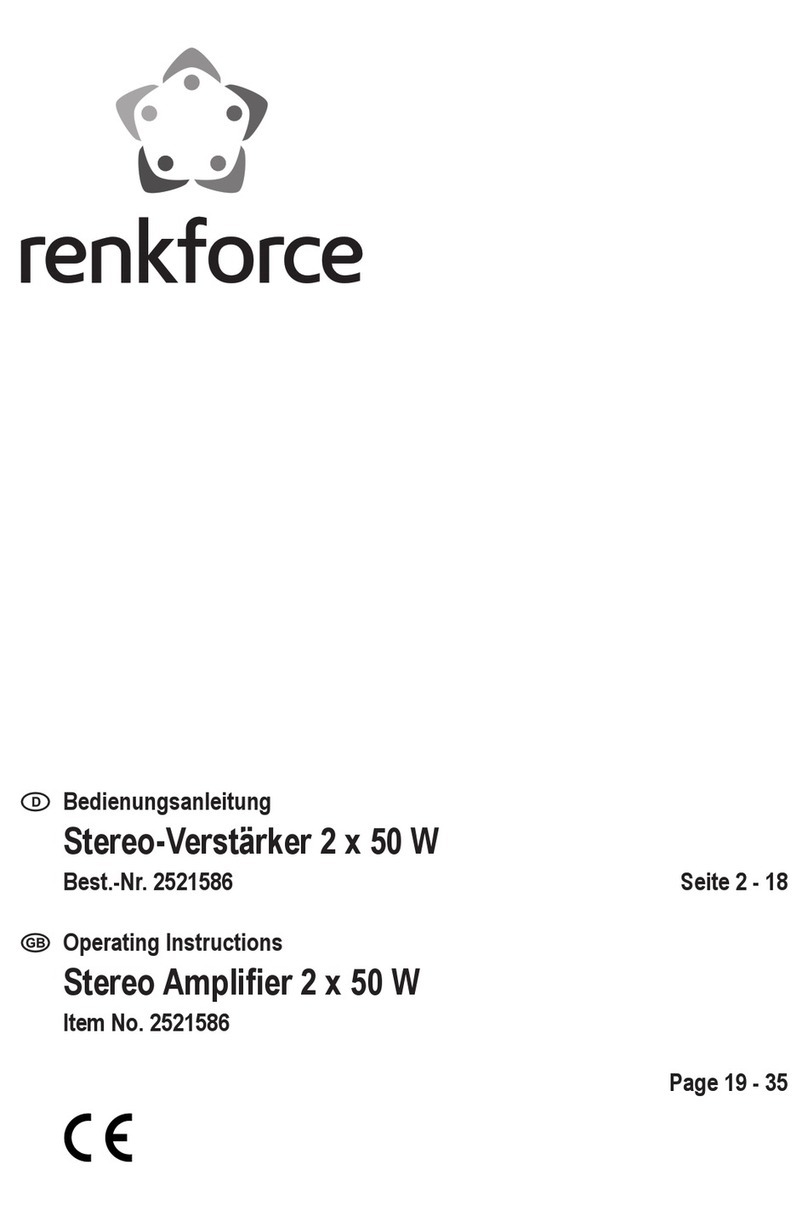
Renkforce
Renkforce RF-WAM-300 operating instructions
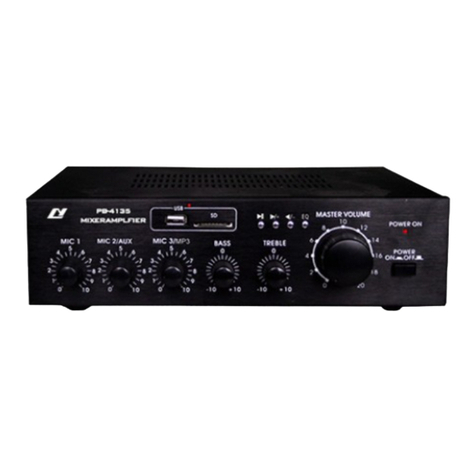
LY International Electronics
LY International Electronics PB-4135 manual
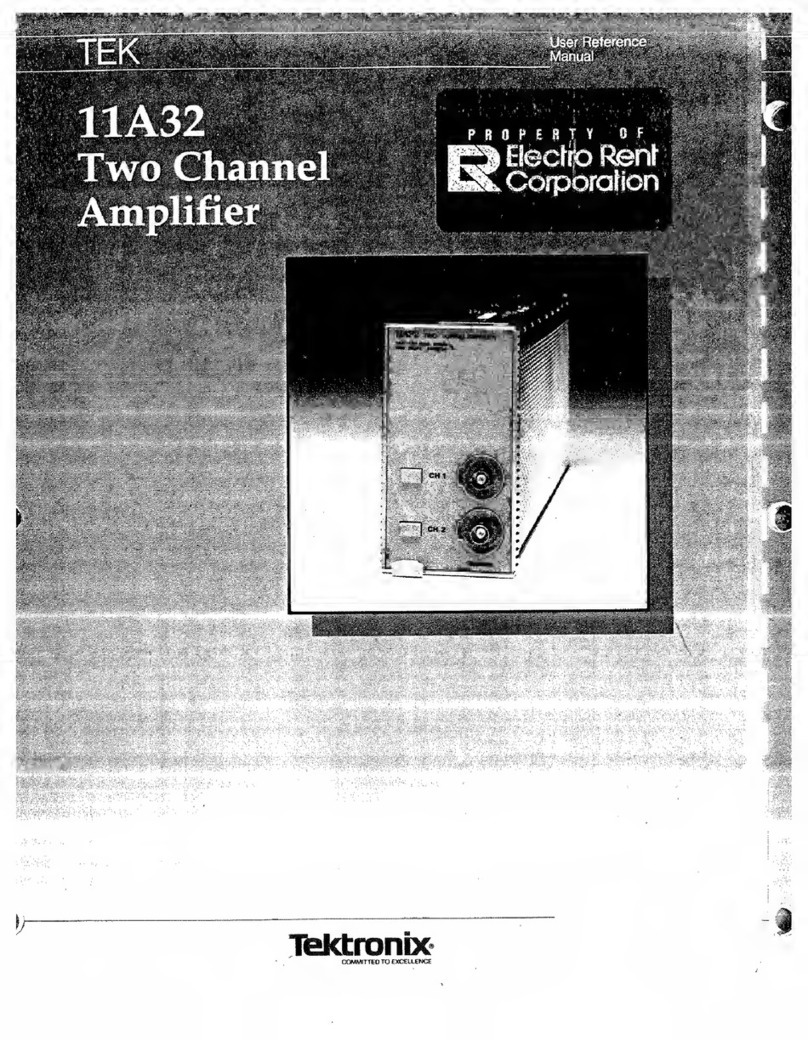
Tektronix
Tektronix 11A32 User's reference manual

Rane
Rane DA 26S Operator's manual

